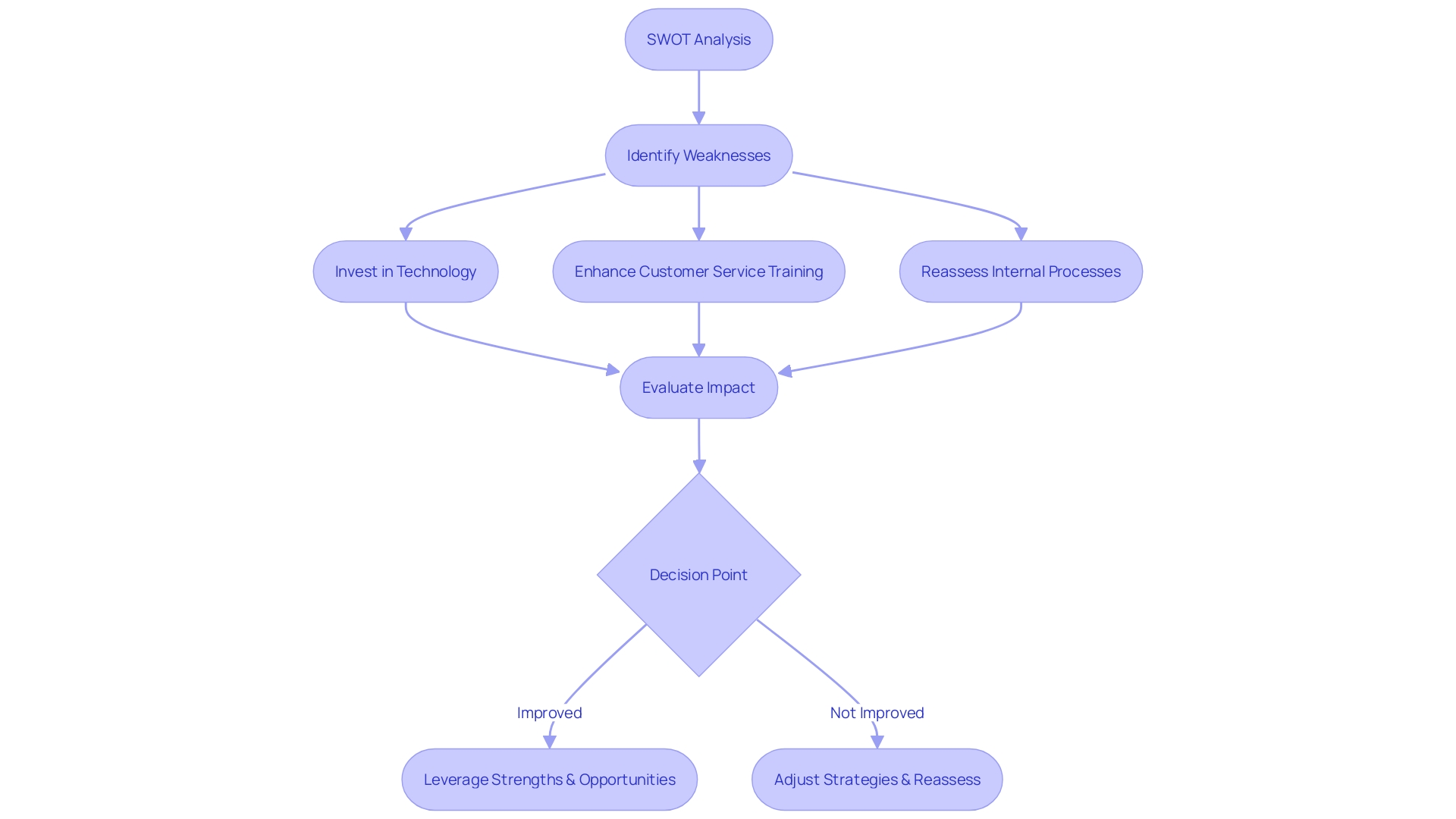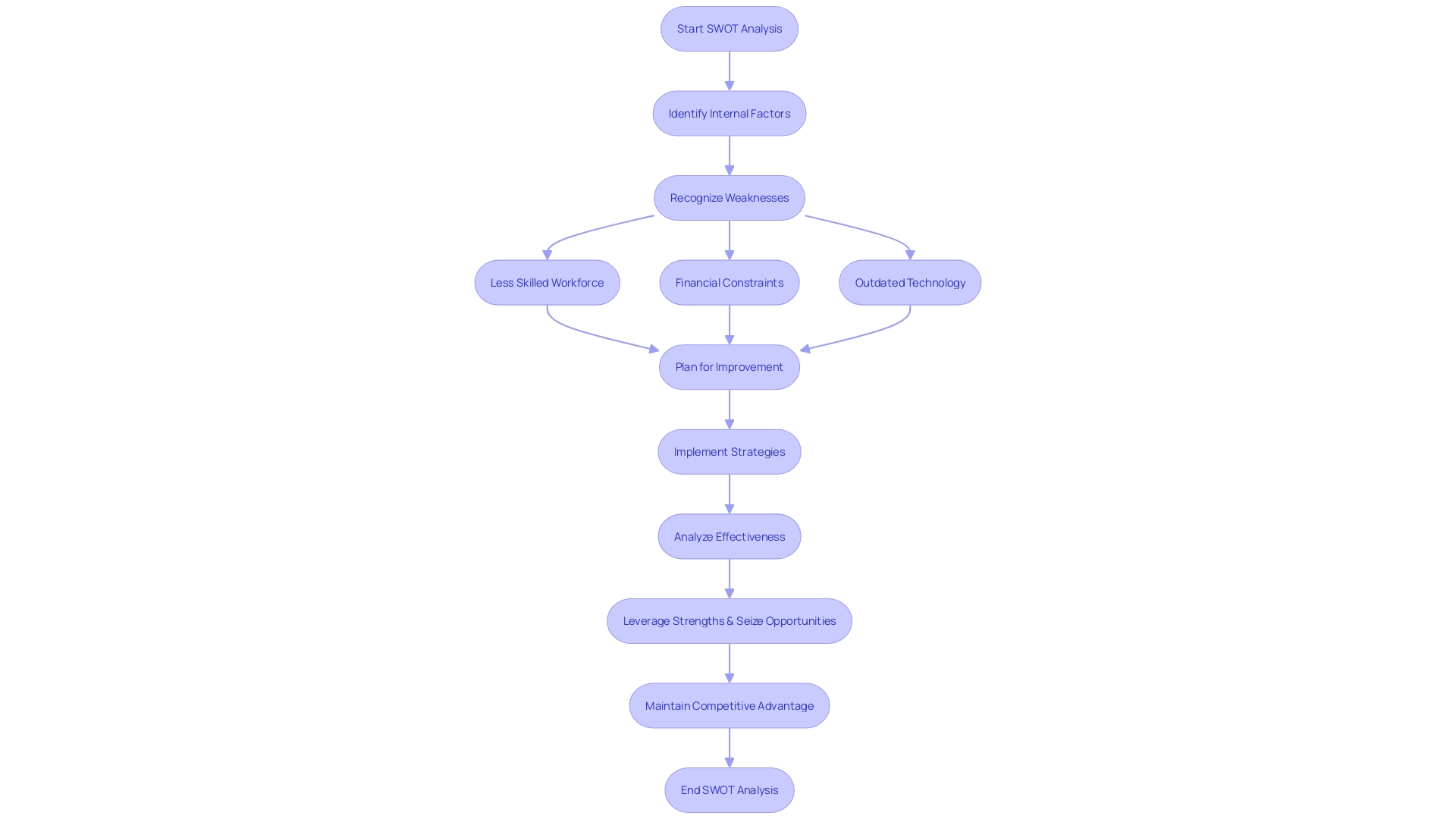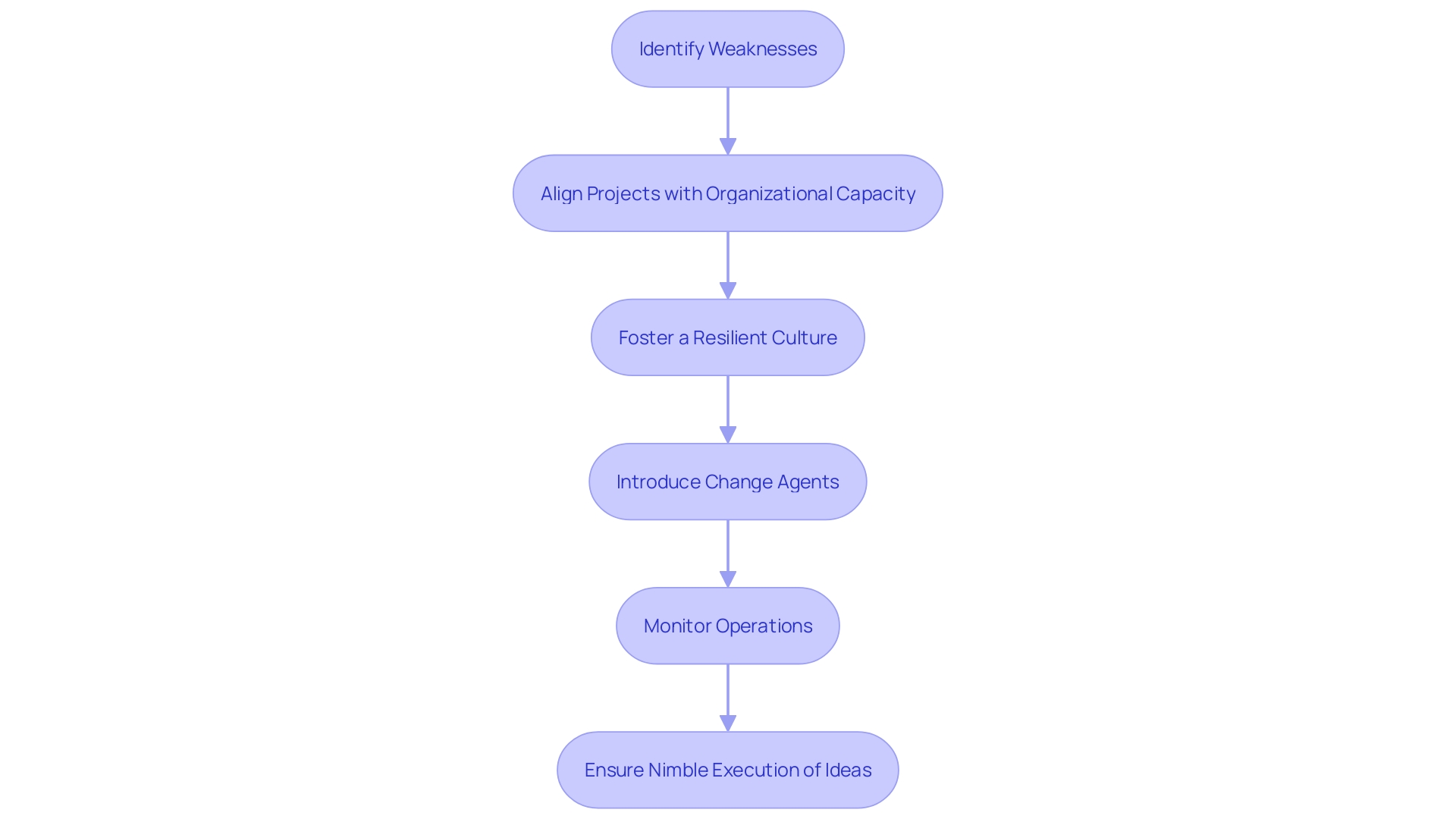Introduction
A SWOT analysis is a powerful tool that allows businesses to gain a comprehensive understanding of their internal strengths, weaknesses, external opportunities, and threats. In this article, we will delve into the crucial aspect of identifying and addressing weaknesses within the SWOT framework. By recognizing and strategically managing weaknesses, organizations can navigate potential challenges and transform them into actionable strategies for growth and sustainability.
Weaknesses in a SWOT analysis refer to internal factors that may hinder an organization's progress or competitive edge. These vulnerabilities can range from inadequate research and development facilities to outdated technology, a weak brand image, or a scarcity of skilled personnel. By acknowledging these weaknesses, businesses can develop targeted action plans to improve or mitigate their impact.
For example, a company may discover that its customer service is not as responsive as competitors', leading to a loss in client trust and revenue. Through a thorough SWOT analysis, this insight prompts an action plan to enhance training for customer service representatives or invest in a more efficient customer relationship management system.
Moreover, even the most sound organizations can encounter weaknesses in their operations, such as system glitches or calculation errors. This highlights the importance of rigorous analysis and continuous reassessment of internal processes.
The key to identifying weaknesses is not to dwell on the negatives but to strategically manage them, preventing them from undermining the organization's opportunities and strengths. By leveraging the insights gained from a SWOT analysis, businesses can position themselves for success by converting potential challenges into actionable strategies for growth and sustainability.
Understanding SWOT Components
Diving into the core of a SWOT analysis, we must scrutinize the 'W'—weaknesses—that can hinder a firm's ability to compete. These internal vulnerabilities may range from inadequate research and development facilities to a thin managerial bench, outdated technology, or even a weak brand image. Imagine a scenario where an organization's financial health is not robust enough to invest in new technology, which is a common weakness many companies face.
By acknowledging such weaknesses, businesses can formulate strategies to improve or manage them.
For instance, a company may recognize that its customer service is not as responsive as competitors', which could lead to a loss in client trust and, consequently, revenue. This insight, gained from a thorough SWOT analysis, prompts an action plan to enhance training for customer service representatives or to invest in a more efficient customer relationship management system.
Moreover, in light of recent events highlighted by Nats and Norway's sovereign wealth fund, even the most sound organizations can encounter weaknesses in their operations—be it a glitch in system software or a calculation error. Such instances underscore the importance of rigorous analysis and the need for continuous reassessment of internal processes.
Ultimately, identifying weaknesses is not about dwelling on the negatives but rather about strategically managing them to prevent them from undermining the organization's opportunities and strengths. It's a critical step to not only navigate through but also to convert potential challenges into actionable strategies for growth and sustainability.

Identifying Weaknesses in a SWOT Analysis
Identifying weaknesses in an organization or project is a crucial component of a SWOT (Strengths, Weaknesses, Opportunities, and Threats) analysis. These weaknesses are internal factors that may impede progress or areas where your business might not have a competitive edge. It's essential to recognize these vulnerabilities to manage and strategize effectively.
A weakness could stem from various aspects, such as less skilled workforce, financial constraints, or outdated technology. By pinpointing these areas, you can devise plans to improve or mitigate their impact.
Engaging in a SWOT analysis enables you to take a comprehensive look at your business, including potential blind spots you might have overlooked. This analytical framework not only assists in identifying weaknesses but also helps you leverage your strengths and seize opportunities to overcome challenges. Regularly updated SWOT assessments provide the agility to adapt to evolving market conditions, thereby maintaining a competitive advantage.
It's a strategic tool used by businesses at different stages for assessing their market position or before major company actions, ensuring that strategies are well-aligned with internal capabilities and external market dynamics.

Examples of Common Weaknesses
A SWOT analysis provides a panoramic view of an organization's landscape by identifying the internal strengths and weaknesses, alongside external opportunities and threats. Weaknesses, in particular, are internal factors that can hinder an organization's ability to achieve its goals. Let's delve into some typical weaknesses that might resonate with many companies.
One such example is financial management, which, if not handled with precision and foresight, can disrupt cash flow and impede growth. Technological lag is another weakness; for instance, Toyota's Woven Planet venture aimed to create a unified software ecosystem for its vehicles but faced setbacks due to overly ambitious targets and delays in software delivery. This underscores the importance of aligning innovation with practical timelines and market readiness.
Additionally, a scarcity of skilled personnel can stifle an organization's ability to innovate and maintain a competitive edge. By recognizing these weaknesses through a SWOT analysis, organizations like Toyota can strategize to overcome these hurdles, harnessing their strengths to capitalize on opportunities in the fast-evolving business environment.
How to Analyze and Address Weaknesses
A SWOT analysis offers a comprehensive snapshot of your company by highlighting its Strengths, Weaknesses, Opportunities, and Threats. This approach not only underscores what your company excels at but also sheds light on areas that require improvement. To fully harness the potential of a SWOT analysis, it's crucial to meticulously examine the weaknesses discovered.
Doing so enables you to prioritize them effectively and formulate robust action plans aimed at mitigating these vulnerabilities.
For instance, a SWOT analysis might reveal that a key weakness is the company's dependency on a limited number of clients. This realization can prompt strategies to diversify the client base and reduce risk. Alternatively, if the analysis points to outdated technology as a weakness, the company can explore investing in new tech solutions to enhance efficiency and competitiveness.
Additionally, when assessing weaknesses, it's essential to distinguish them from threats, which are external factors beyond your control, like market volatility or regulatory changes. While threats require a different strategic response, such as risk management or scenario planning, weaknesses are internal issues that can often be rectified with targeted actions. A well-executed SWOT analysis not only helps in identifying and prioritizing weaknesses but also in leveraging your strengths to address them, ultimately positioning your business for success in a dynamic environment.
Steps to Conduct a SWOT Analysis Focused on Weaknesses
A meticulous approach to SWOT analysis centered on weaknesses can be pivotal for businesses looking to enhance their strategic planning. To effectively focus on weaknesses within the SWOT framework, it is essential to gather comprehensive data, engage key stakeholders, and foster productive dialogue. By dissecting the internal factors that may be hindering your organization, such as process inefficiencies or gaps in expertise, you can develop targeted strategies to address these areas.
Moreover, understanding how external factors, like economic shifts or technological advancements, might exacerbate these weaknesses allows for a more nuanced strategy. Engaging stakeholders in this analysis ensures a diverse range of perspectives, which can lead to more innovative and effective solutions. This structured process not only aids in recognizing and managing weaknesses but also sets the stage to leverage organizational strengths and seize external opportunities, ultimately safeguarding against potential threats.
Integrating Weakness Analysis with Strengths, Opportunities, and Threats
Integrating weaknesses with other SWOT components is essential for crafting comprehensive strategies. By examining strengths, such as organizational capabilities or financial robustness, alongside weaknesses, businesses can create more dynamic action plans. For instance, a company's strong market presence can be leveraged to overcome the weakness of a limited product line.
Opportunities, when viewed through the lens of weaknesses, can lead to proactive measures, such as leveraging a technological edge to counteract emerging competitors. Conversely, understanding threats, like potential economic downturns or regulatory changes, allows for preemptive planning to mitigate risks that could exploit existing weaknesses. Regular SWOT assessments are advised to ensure that strategies remain aligned with the fluctuating business environment, ultimately maintaining a competitive edge.
Case Studies: Real-World Examples of Addressing Weaknesses
Delving into actual cases, businesses have adeptly employed SWOT analysis to identify and navigate through their internal weaknesses. By confronting these challenges head-on, organizations have fortified their operations and steered toward success. Let's explore some of these situations to better understand how companies can turn potential pitfalls into stepping stones for achievement.
In the realm of strategic planning, SWOT analysis emerges as a pivotal tool, enabling organizations to discern beneficial and detrimental factors both within and beyond their control. By analyzing strengths, weaknesses, opportunities, and threats, businesses gain a comprehensive overview of their standing in the industry. This insight is instrumental in crafting strategies that leverage organizational strengths to address weaknesses and respond proactively to the business environment.
One illustrative example is a company that capitalized on its robust technological capabilities, a strength, to overcome a weakness in market reach. By deploying innovative tech solutions, it expanded its customer base and improved its position in the market. Meanwhile, another organization might pinpoint a skilled workforce as a strength and harness this advantage to address financial challenges, thus securing a more stable economic footing.
Moreover, SWOT analysis is not a static tool but a dynamic framework that encourages regular reevaluation. As such, businesses can maintain a competitive edge by adapting to market shifts. Engaging stakeholders in this process ensures that a diverse range of perspectives contributes to a more nuanced analysis.
SWOT analysis is also beneficial for startups, serving as a foundation for strategic planning. It enables new ventures to chart a clear path forward by aligning goals with market conditions and internal capabilities. In this way, startups can tackle the entrepreneurial landscape with informed confidence.
By examining these examples, we see the utility of SWOT analysis in providing a structured approach to understanding both internal and external factors that can influence business outcomes. It offers a visual matrix that succinctly presents the organization's strengths and weaknesses, alongside external opportunities and threats. This clarity aids stakeholders in identifying strategic priorities, promoting discussions that guide effective strategy formulation.
Best Practices for Overcoming Identified Weaknesses
Successful organizations recognize that weaknesses aren't an endpoint but a springboard for transformation. Take, for instance, Toyota's venture, Woven Planet, which set out to create a universal software standard for the industry. The project entailed ambitious undertakings such as a prototype city to test self-driving cars and a versatile operating system capable of connecting to a cloud network.
Despite these innovative concepts, the initiative stumbled due to misaligned zone management and the challenge of fitting a grand vision within the practical timelines of car launches. This reveals the critical importance of aligning ambitious projects with the organization's capacity to execute and the necessity of adaptable zone management.
In practice, addressing weaknesses is less about isolated fixes and more about fostering a resilient organizational culture. For example, practices such as 'After Action Reviews' and welcoming incomplete ideas can build psychological safety, enabling teams to navigate revolutionary crisis phases highlighted by theorists like Greiner. Moreover, introducing change agents who can constructively challenge existing paradigms is crucial for organizations facing the Innovator's Dilemma' and the rapid technological advancements of competitors.
Organizations must also have a clear dashboard to monitor their systems and feature flags, ensuring they are prepared for capacity and throughput demands. The agility to adapt is demonstrated by companies that recognize false agility—those merely adopting agile practices without achieving the culture and productivity benefits. Research shows that while many companies claim agile transformations, only half experience the full benefits, such as reduced delivery costs and faster time to market.
Therefore, overcoming weaknesses involves a comprehensive approach that includes monitoring operations closely, fostering an innovative culture, and ensuring that execution is as nimble as the ideas themselves.

Conclusion
In conclusion, a SWOT analysis is a powerful tool for businesses to gain a comprehensive understanding of their internal strengths, weaknesses, external opportunities, and threats. By strategically managing weaknesses, organizations can navigate potential challenges and transform them into actionable strategies for growth and sustainability.
Recognizing weaknesses is not about dwelling on the negatives, but taking action to prevent them from undermining opportunities and strengths. Through a SWOT analysis, businesses can develop targeted action plans to improve or mitigate the impact of weaknesses.
Integrating weaknesses with other SWOT components allows for the creation of comprehensive strategies. Examining strengths alongside weaknesses enables businesses to leverage capabilities to overcome limitations. Understanding how weaknesses can be affected by external factors helps in preemptive planning to mitigate risks.
Real-world case studies demonstrate the effectiveness of SWOT analysis in identifying and addressing weaknesses. By confronting these challenges head-on, organizations have fortified their operations and steered toward success. Regular reevaluation of the SWOT analysis ensures adaptability and a competitive edge.
Overcoming weaknesses involves fostering a resilient organizational culture. Practices like "After Action Reviews" and welcoming incomplete ideas build psychological safety, enabling teams to navigate revolutionary crisis phases. Introducing change agents who challenge existing paradigms is crucial in the face of rapid technological advancements.
To overcome weaknesses, organizations must monitor systems closely and ensure agility in execution. Having a clear dashboard and being prepared for capacity demands fosters innovation and nimble execution.
In conclusion, a SWOT analysis focused on weaknesses provides valuable insights to manage and address internal factors. By leveraging these insights, organizations position themselves for success by converting potential challenges into actionable strategies for growth and sustainability.




